Chapter 4: Parts of the Cells
1/59
There's no tags or description
Looks like no tags are added yet.
Name | Mastery | Learn | Test | Matching | Spaced |
|---|
No study sessions yet.
60 Terms
What are the three domains:
1) Eukarya
2) Bacteria
3) Archaea
Describe Eukarya Domain:
made up of eukaryotic cells
- having a nucleus and internal membrane system
- both single and multi-cell organisms
Describe Bacteria Domain:
prokaryotic cells
- NOT having a nucleus and internal membrane system
- single-celled only
- "germs" = pathogenic bacteria
Describe Archaea Domain:
prokaryotic cells
- NOT having a nucleus and internal membrane system
- single-celled only
- no pathogens (at this time)
- extremophiles: cells have unique adaptations for living in extreme environments
- more similar genetically to Eukarya than bacteria
-PROKARYOTIC SECTION-
-PROKARYOTIC SECTION-
Basic Prokaryotic Cell Image:
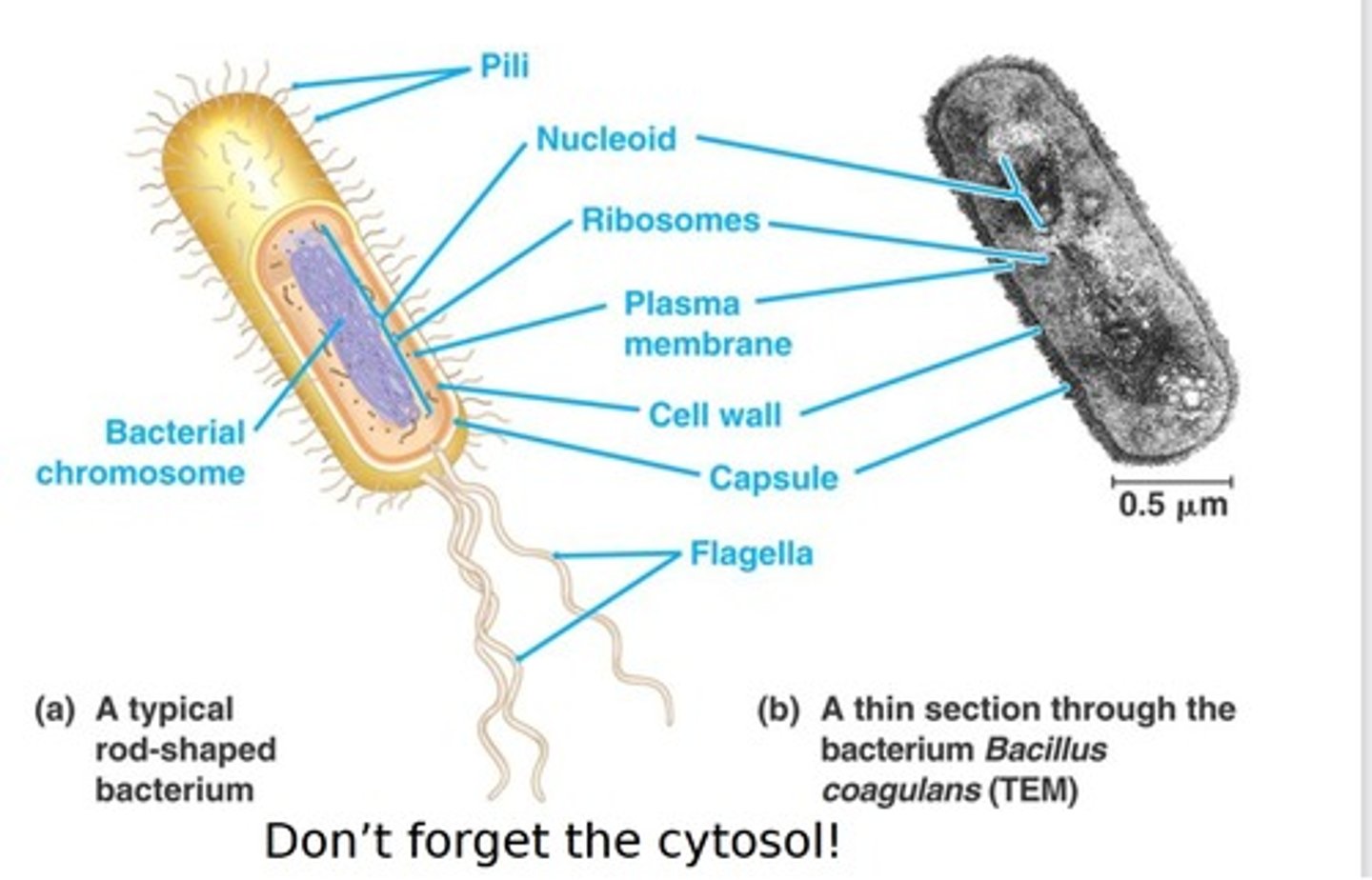
Parts of the Prokaryotic Cells:
1) Glycocalyx
2) Cell Wall
3) The Plasma Membrane
4) Flagella and other external structures
5) Pili and fimbriae
6) Cytoplasm
7) The nucleoid: DNA + plasmids
8) Ribosomes
9) Endospore
Glycocalyx (prokaryotic) Info and Image:
a polysaccharide secreted outside the cell wall
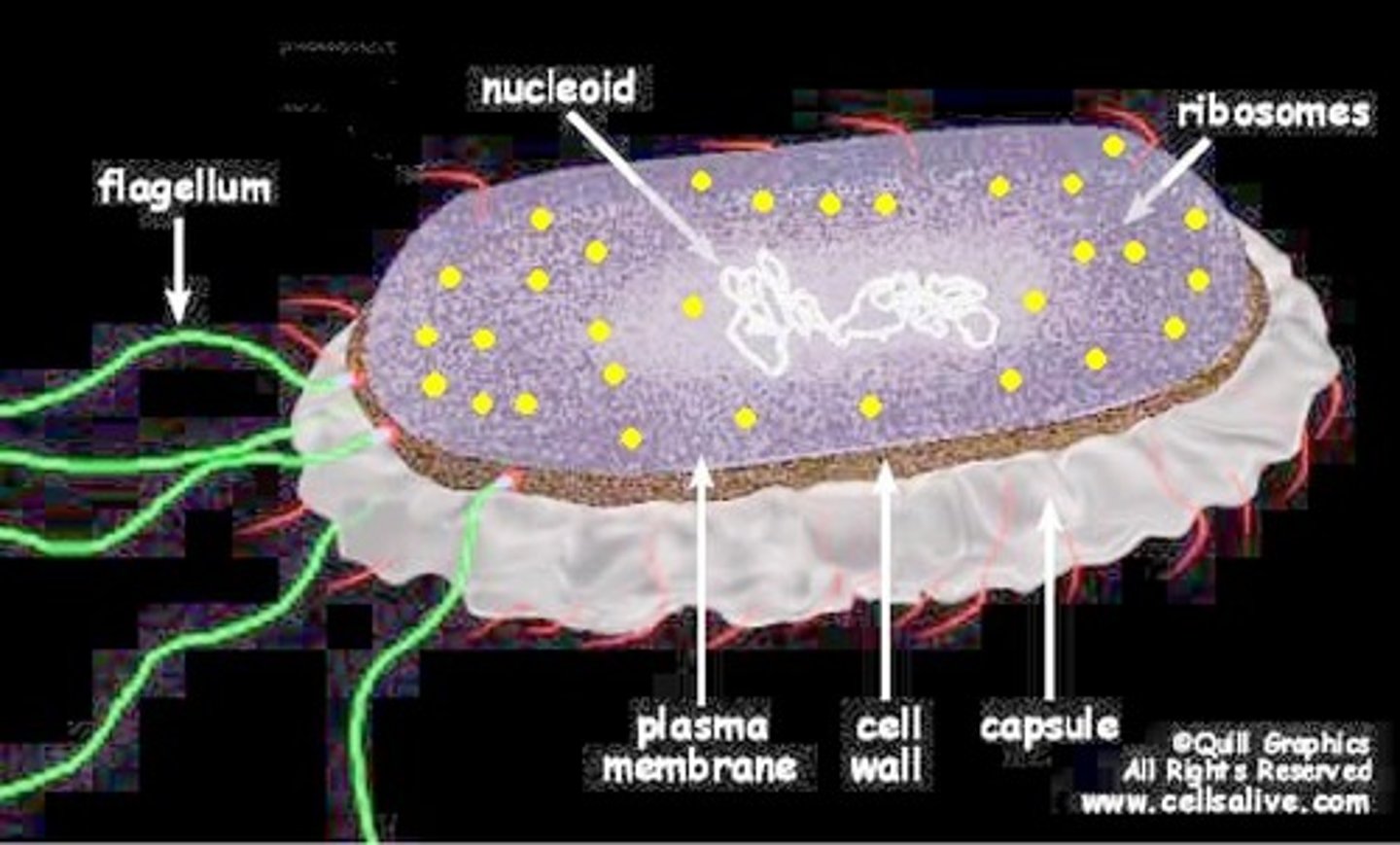
Glycocalyx two types
- two types: Capsule and Slime Layer
Capsule structure and function:
- rigidly organized
- increases pathogenicity
- helps the bacteria hide from the immune system
Slime Layer: structure and function:
- loosely organized
- helps initiate an infection
- helps bacteria stick to surfaces
Cell Wall (prokaryotic) Info:
-a polysaccharide: the chains are linked together by short polypeptides
Primary component of Cell Wall:
peptidoglycan
Two types of cell wall
Gram Positive and Gram Negative
Antibiotics in relation to Cell Walls:
- an antibiotic may only be able to penetrate one of the 2 cell wall types
- broad spectrum antibiotics: CAN penetrate both
- gram negative organisms have a toxin in the outer membrane
- an antibiotic may exacerbate the illness by increasing the release of the toxin
- antibiotics are non-specific have low-specificity
- will kill all bacteria within its range including "good" gut bacteria
Gram Positive:
thick layer of peptidoglycan bound to plasma membrane by teichoic acids

Gram Negative:
thin layer of peptidoglycan and a second outer membrane
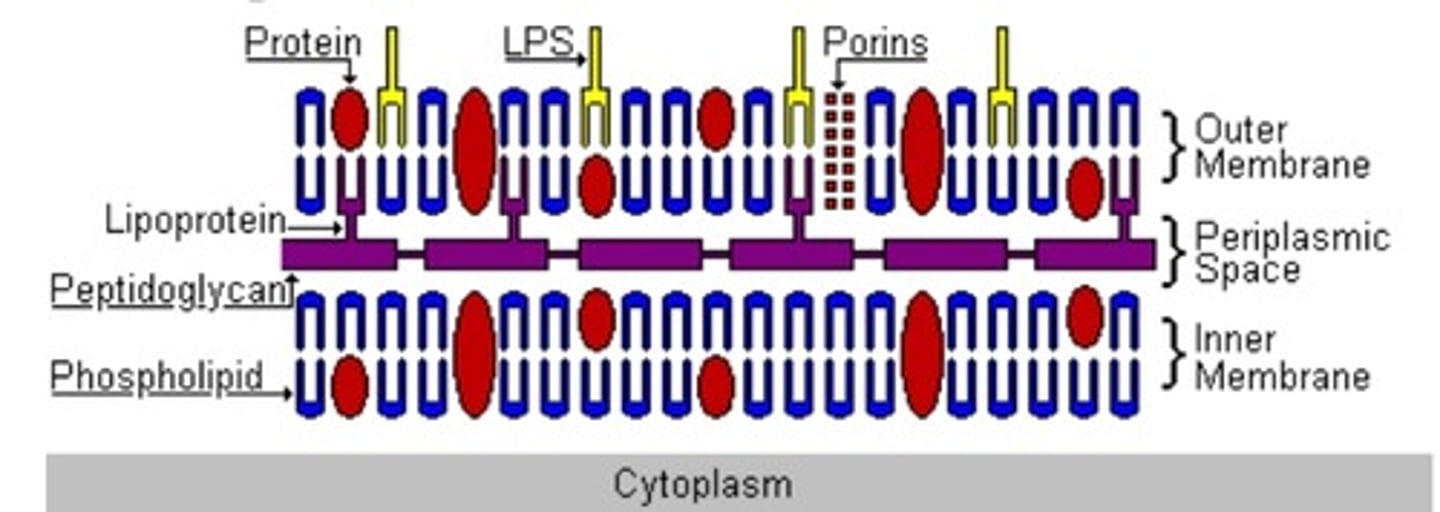
Flagella (prokaryotic) Info and Image:
outside the cell wall
- made of protein flagellin
- arranged in a hollow tube
- a rotor anchors the flagellum in the cell wall
- whirls in a circle
- for motility
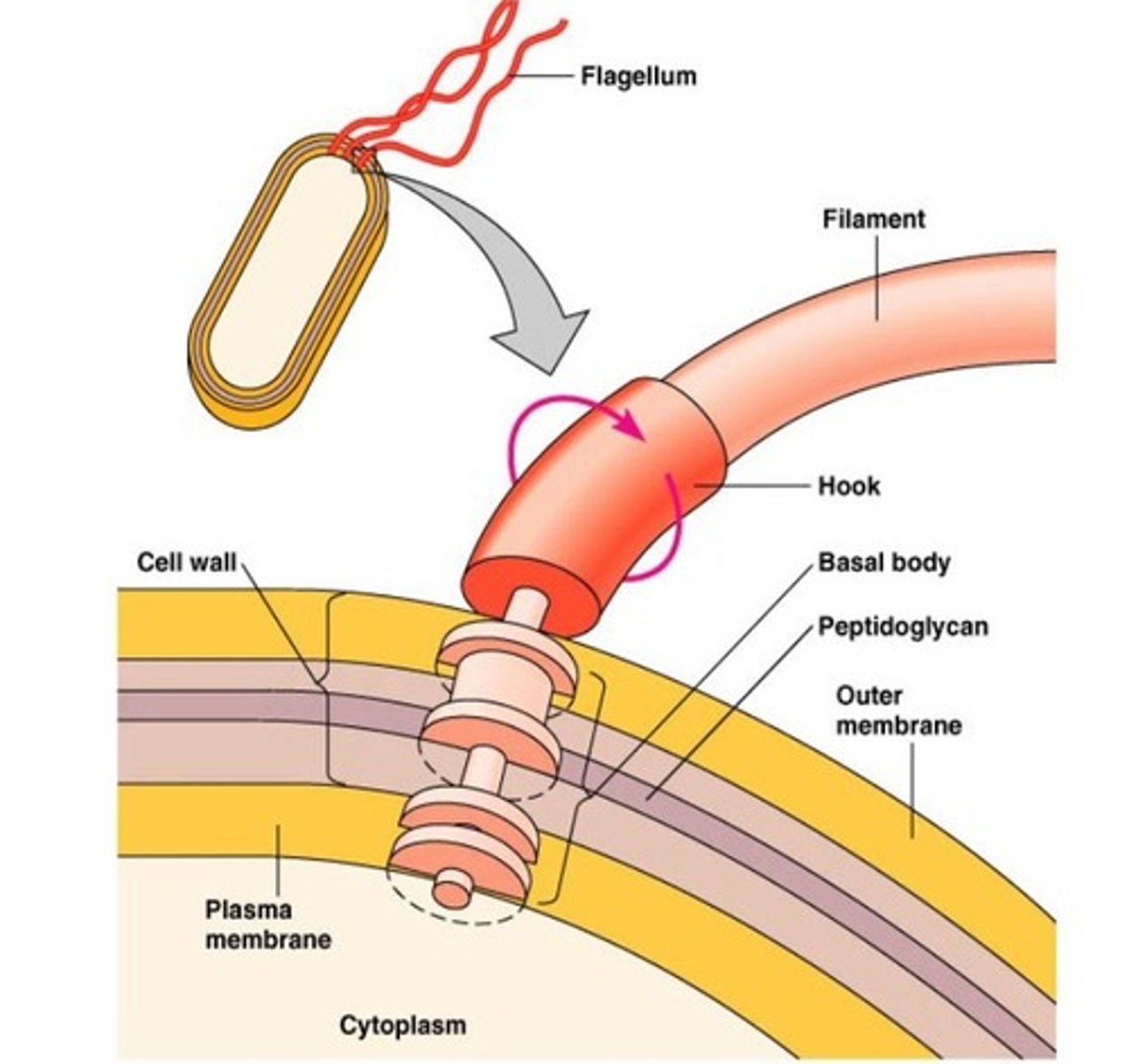
Fimbriae (prokaryotic) Info:
same structure as flagella but shorter
-sticking to surfaces
(-> initiate an infection)
Sex Pilus (pili) (prokaryotic) Info and Image:
- a hollow tube
- a bacteria must have a special gene to build a sex pilus
- any bacteria can receive the pilus
- the "builder" sends a copy of its DNA to the "receiver"
- the "receiver" can "eat" the DNA, or it can integrate the genes into its own chromosome and use them
- the "builder" can share its DNA w/ any other bacterium in the area (it doesn't have to be the same species
- (this is called HORIZONTAL GENE TRANSFER)
- "bacterial sex": the "receiver" becomes a new "offspring" that results from combining DNA from 2 individuals
- this is one way that the genes for antibiotic resistance spread rapidly in a bacterial community
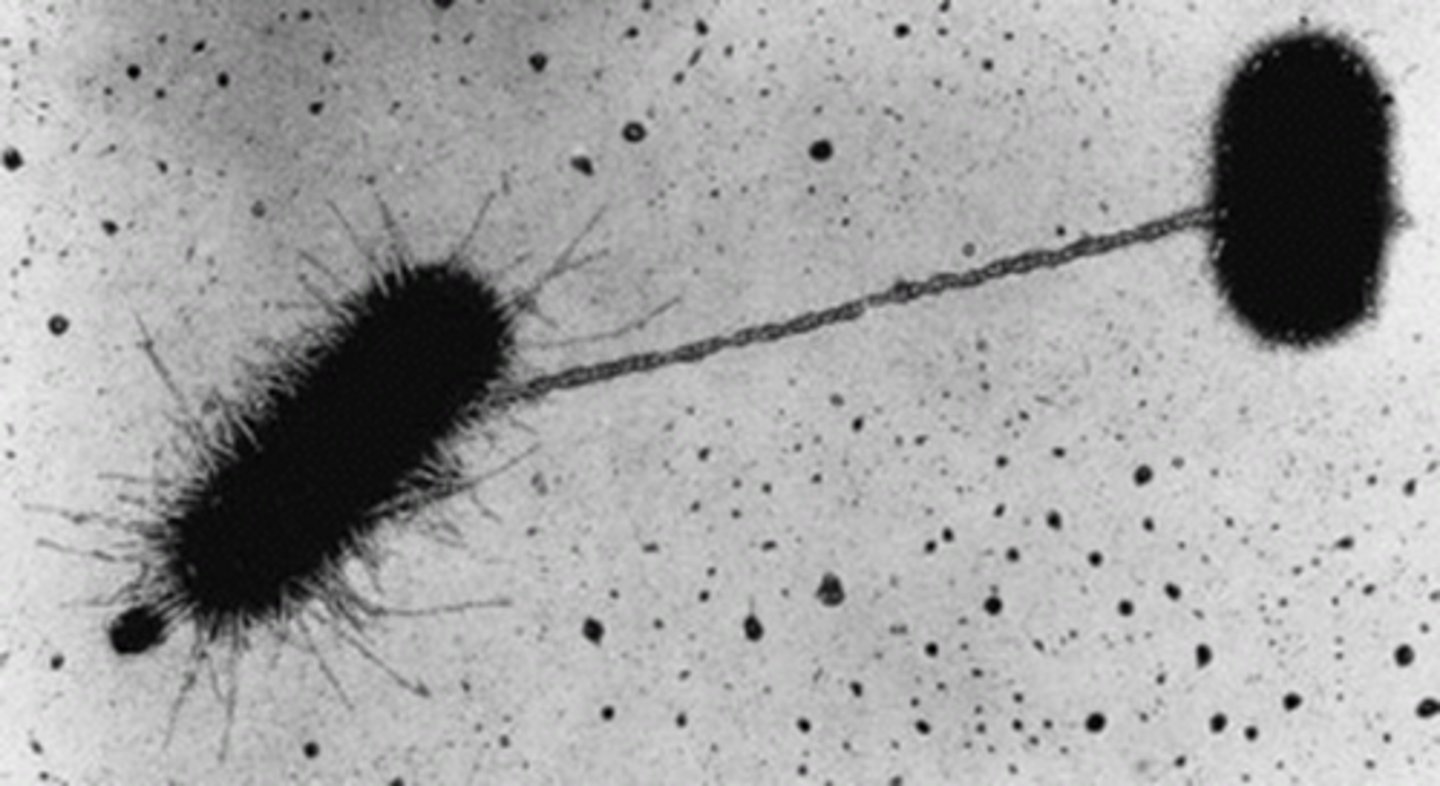
DNA (prokaryotic):
- one circular chromosome which contains all the "normal housekeeping" genes for survival in everyday life
- plasmids: small, circular DNA fragments
-may have multiples of different types of plasmids
-contain genes that may confer an advantage in certain environmental conditions
R plasmids:
genes for antibiotic resistance
F plasmids:
genes for building the sex pilus
Ribosomes (prokaryotic) Info and Image:
-two subunits:
1) Small 30S
2) Large 50S
Assembled: 70S
- "read" mRNA and build a protein
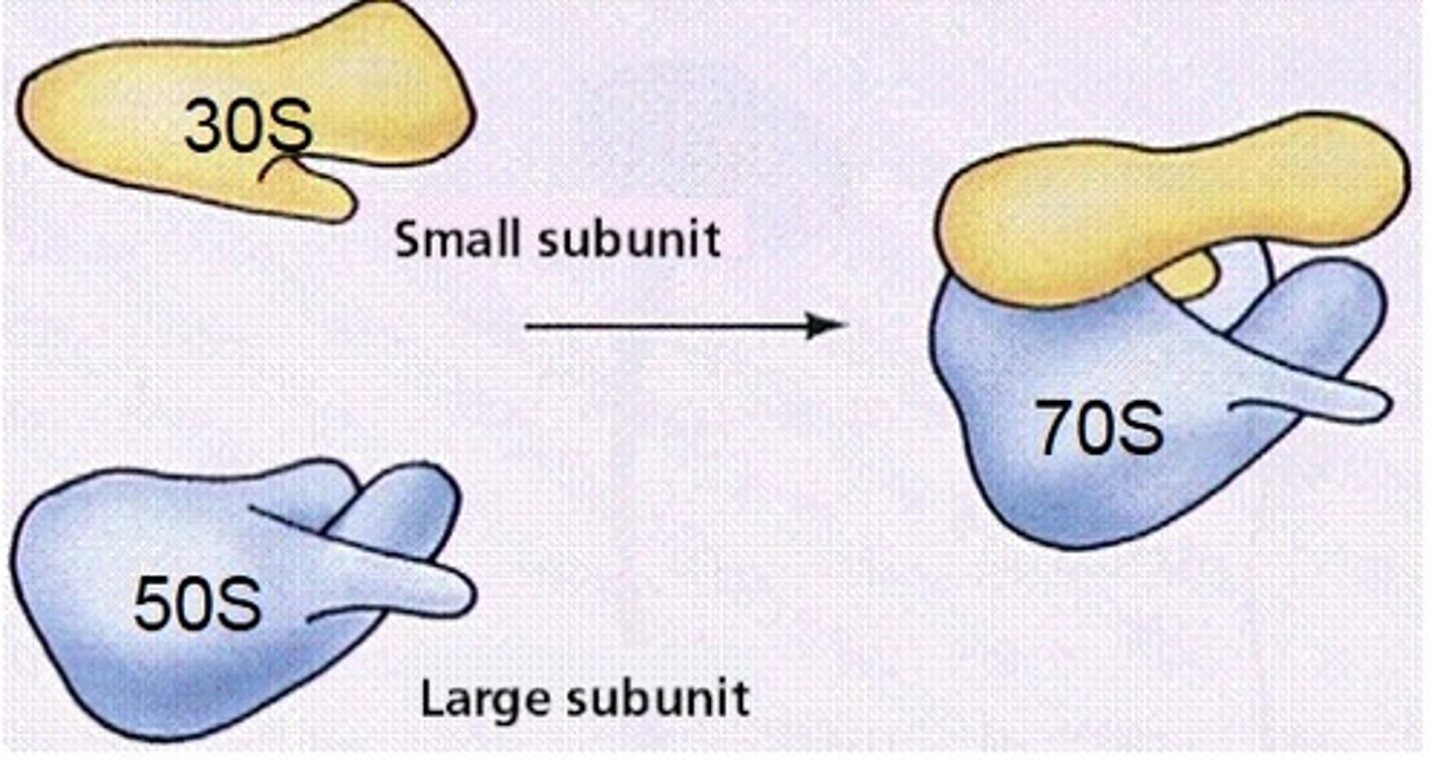
Endospore (prokaryotic):
- not every bacterial species can build an endospore
- when environmental conditions deteriorate an endospore is made. the outer cell dies, releasing the endospore
- the endospore can exist indefinitely and will resume normal function when environmental conditions improve
- we cannot destroy endospores through "normal" food sterilizing procedures
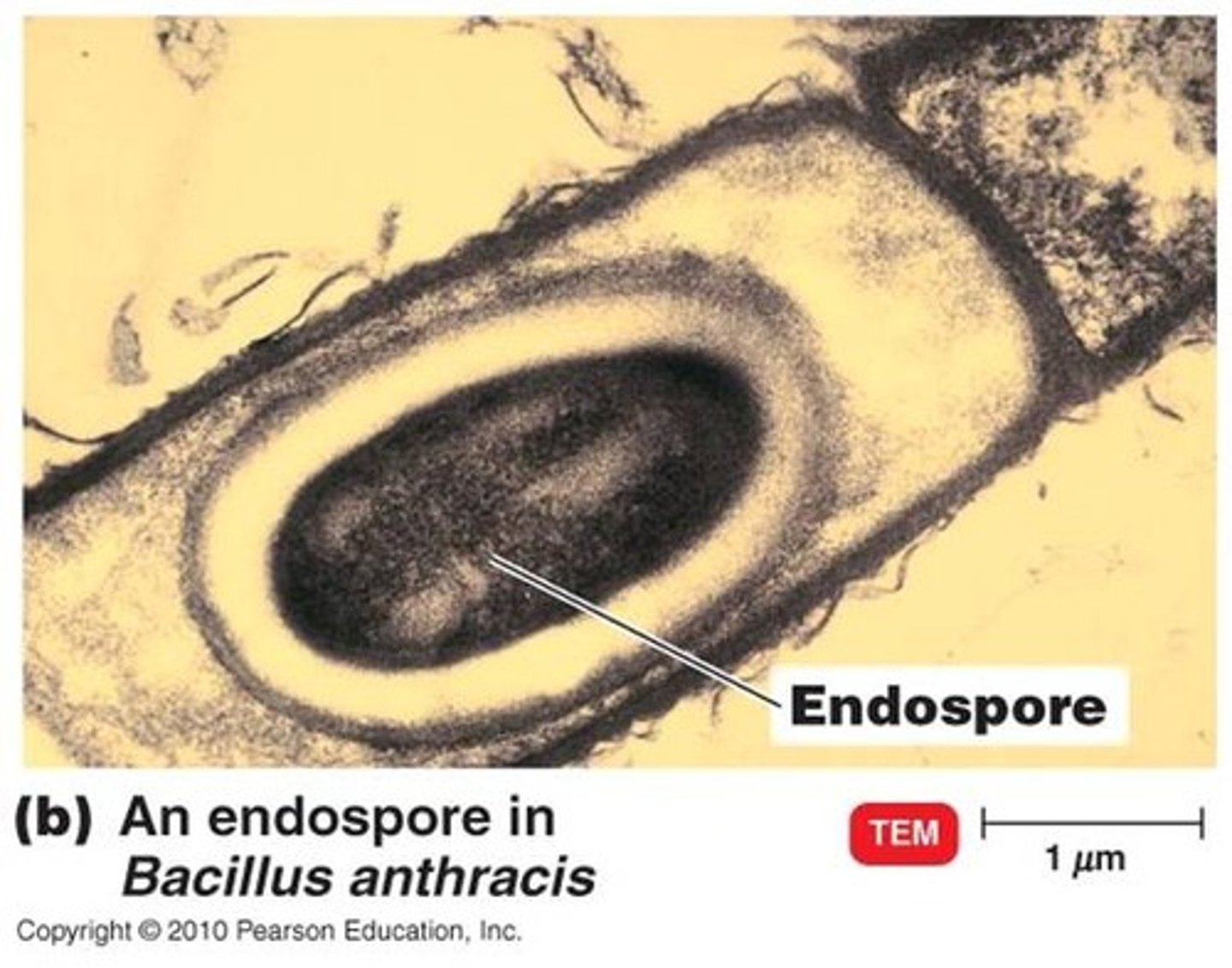
Bacillus anthracis:
- endospore
- agent of anthrax
Clostridium botulinum:
- endospore
- agent of botulism
-EUKARYOTIC SECTION-
-EUKARYOTIC SECTION-
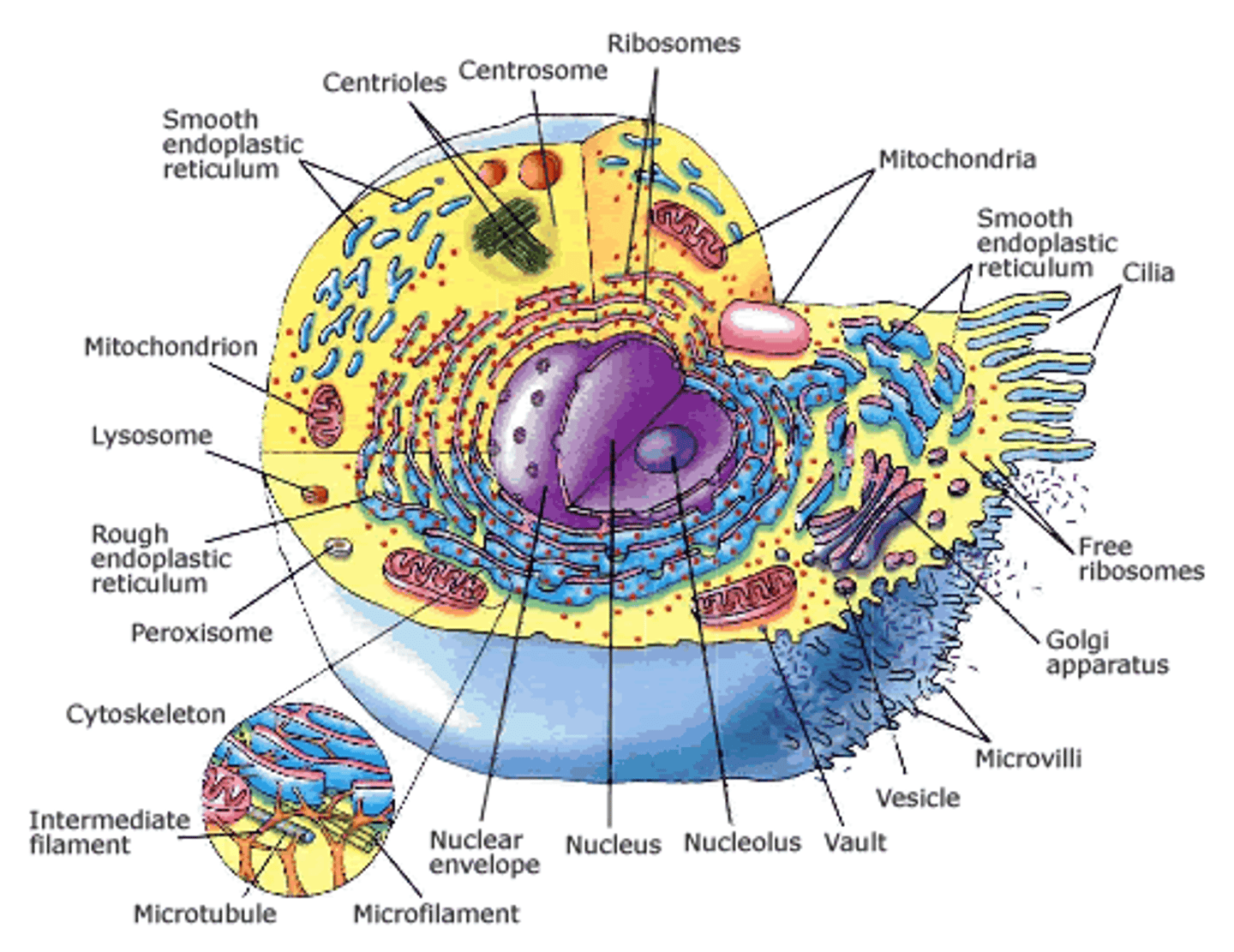
Parts of the Eukaryotic Cells:
1) Flagella and other external structures:
2) Cilia
3) Nucleus and Endoplasmic Reticulum
4) Ribosomes
5) Golgi Apparatus
6) Lysosomes and Vacuoles
7) Mitochondria
8) Chloroplasts
9) Cell wall (not in animal cells)
10) Peroxisomes
11) The cytoskeleton
12) Cell Junctions
Cell wall (eukaryotic) Info:
- plants: cellulose
- fungi: chitin
- animals: none
Flagella (eukaryotic) Info and Image:
- inside the plasma membrane
- complex structure:
- 9 x 2 (9 pairs of microtubules)
- made of protein actin
- for motility
- undulates back and forth
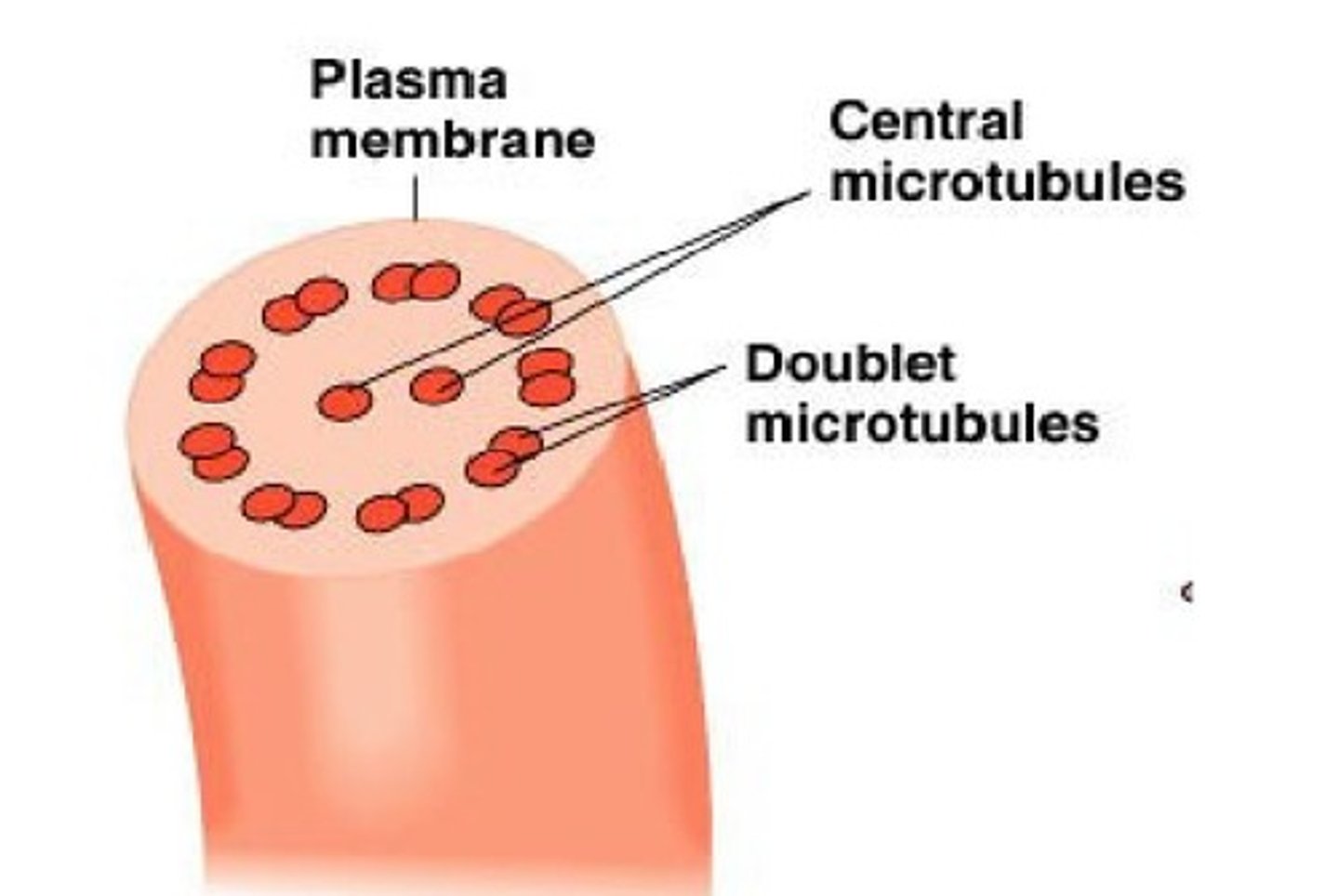
Cilia (eukaryotic) Info and Image:
- same structure as flagella but shorter
- still for motility
- sweep in one direction only
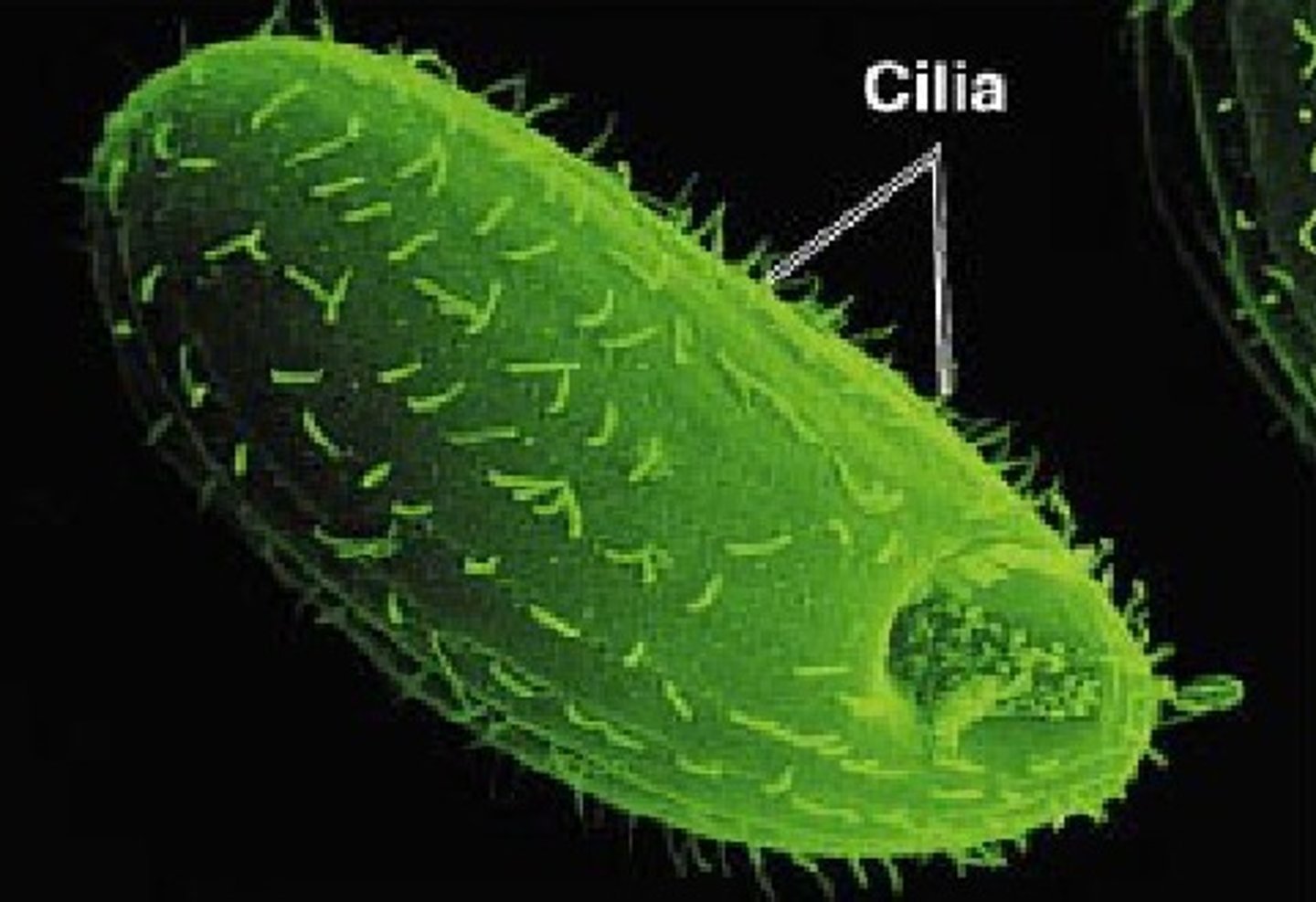
Nucleus
Nuclear envelope & 2 membranes - inner & outer
- Contains genomic DNA
Outer membrane is continuous with the ____
rough ER
Nucleolus
a dense region of DNA where RNA enzymes are made
Nuclear pores
surrounded by "guard" proteins that regulate what can enter or leave the nucleus
Nuclear lamina
a scaffold of intermediate filaments that supports the shape of the nucleus
Endoplasmic Reticulum
a network of tubules surrounding the nucleus
- two types: Rough ER and Smooth ER
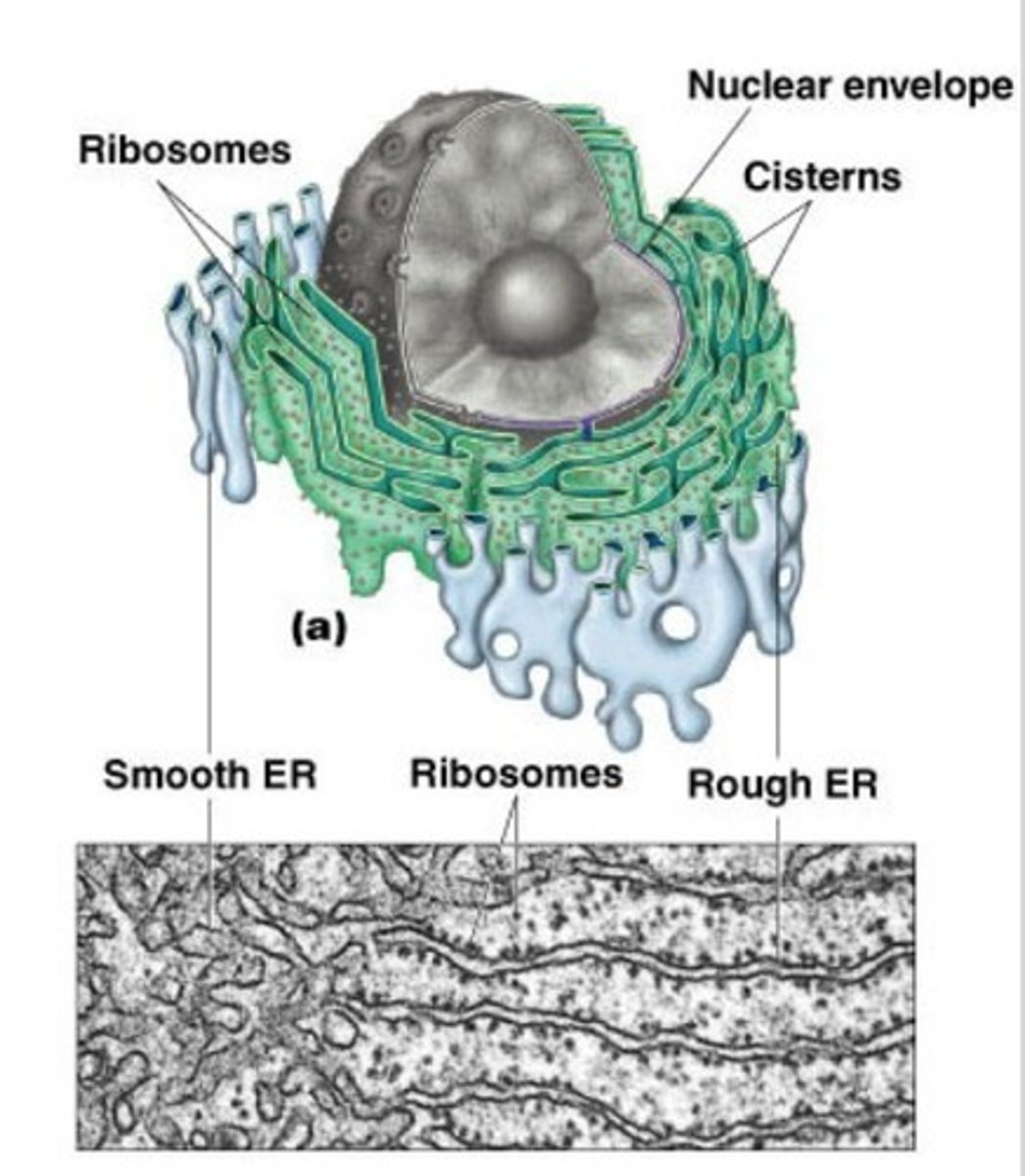
Rough ER Function and Appearance:
has a granulated appearance due to the presence of ribosomes
- Processes proteins that have a special destination, either inside or outside the cell (PSD - proteins with a special destination).
- Building new membrane
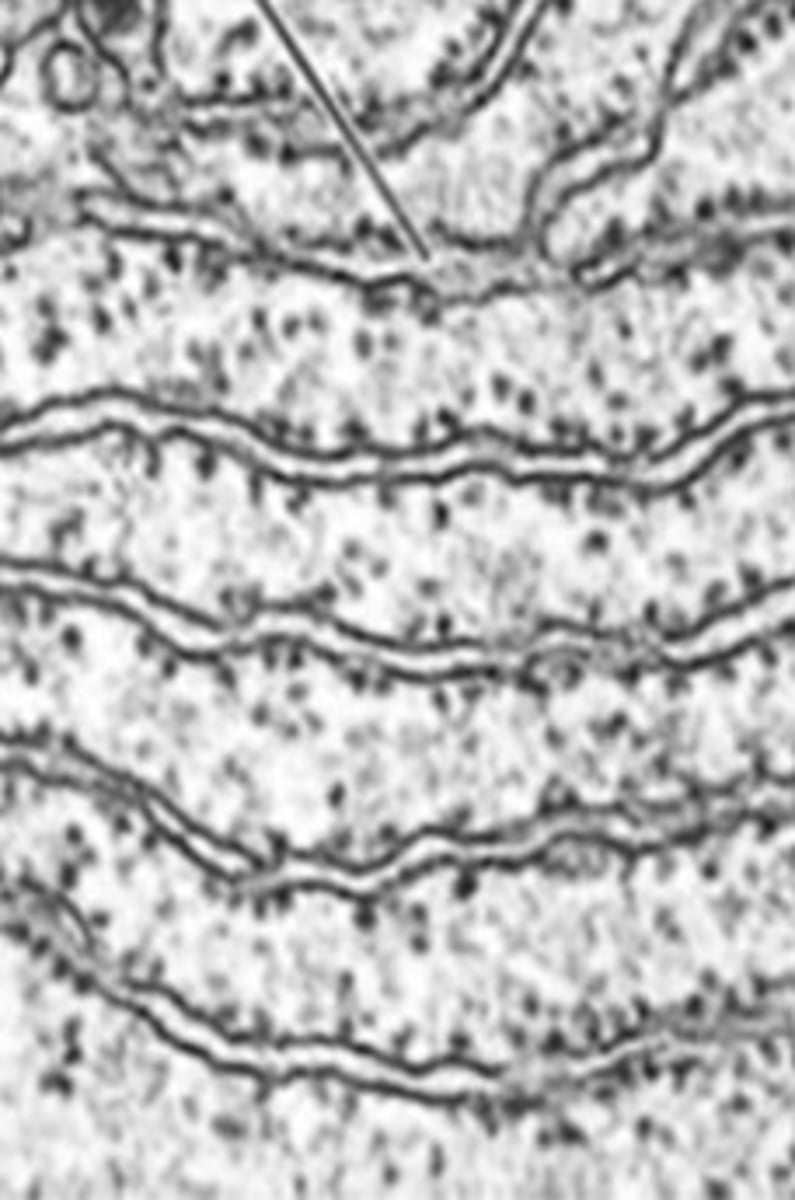
Explain how Rough ER builds new membranes
by putting membrane proteins in the membrane
Smooth ER Function and Appearance:
doesn't work with ribosomes, so no granulated appearance
- Builds lipids
- Builds new membrane
- Detoxification of non-polar drugs
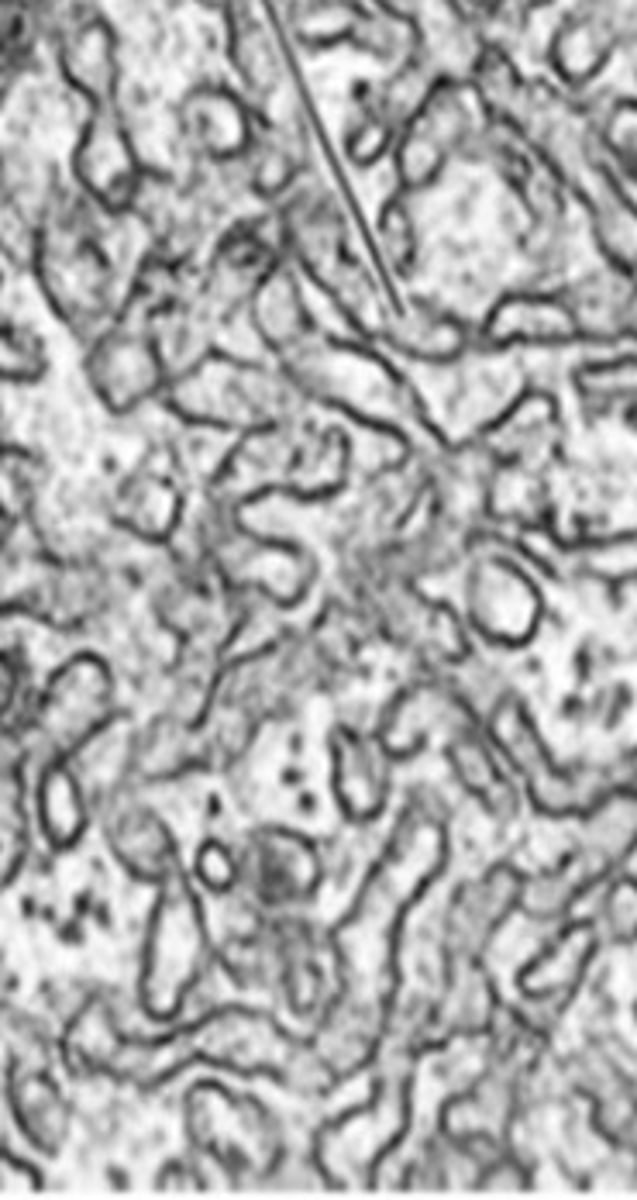
Explain the lipids Smooth ER makes
- Adrenal glands: stress hormones (cortisol)
- Testicles: testosterone
-Ovaries: convert androgens to estrogens.
How does Smooth ER build new membranes
by building the phospholipid component
Explain how Smooth ER does detoxification of non-polar drugs
sticks an OH onto (makes it polar so that it can be filtered out by kidneys)
Ribosomes (eukaryotic) Info and Image:
- two subunits
1) Large 60S
2) Small 40S
Assembled 80S
- read mRNA and build a protein (translation)
- made of protein and RNA
- RNA part is made by nucleolus
- protein part enters nucleus and is assembled with RNA part @ nucleolus
- completed subunits exits nucleus
- the 2 subunits exist independently of each other
- ribosomes are only assembled when on a mRNA
- when translation is complete, the subunits separate
- when a mRNA code codes for a PSD, the ribosome takes the mRNA to the rER
- as translation occurs, the protein is released directly to
the lumen (inside) of the rER
- when translation is complete, the ribosome dissociates from the rER and the 2 subunits dissociate from each other
SPLIT CARD!!
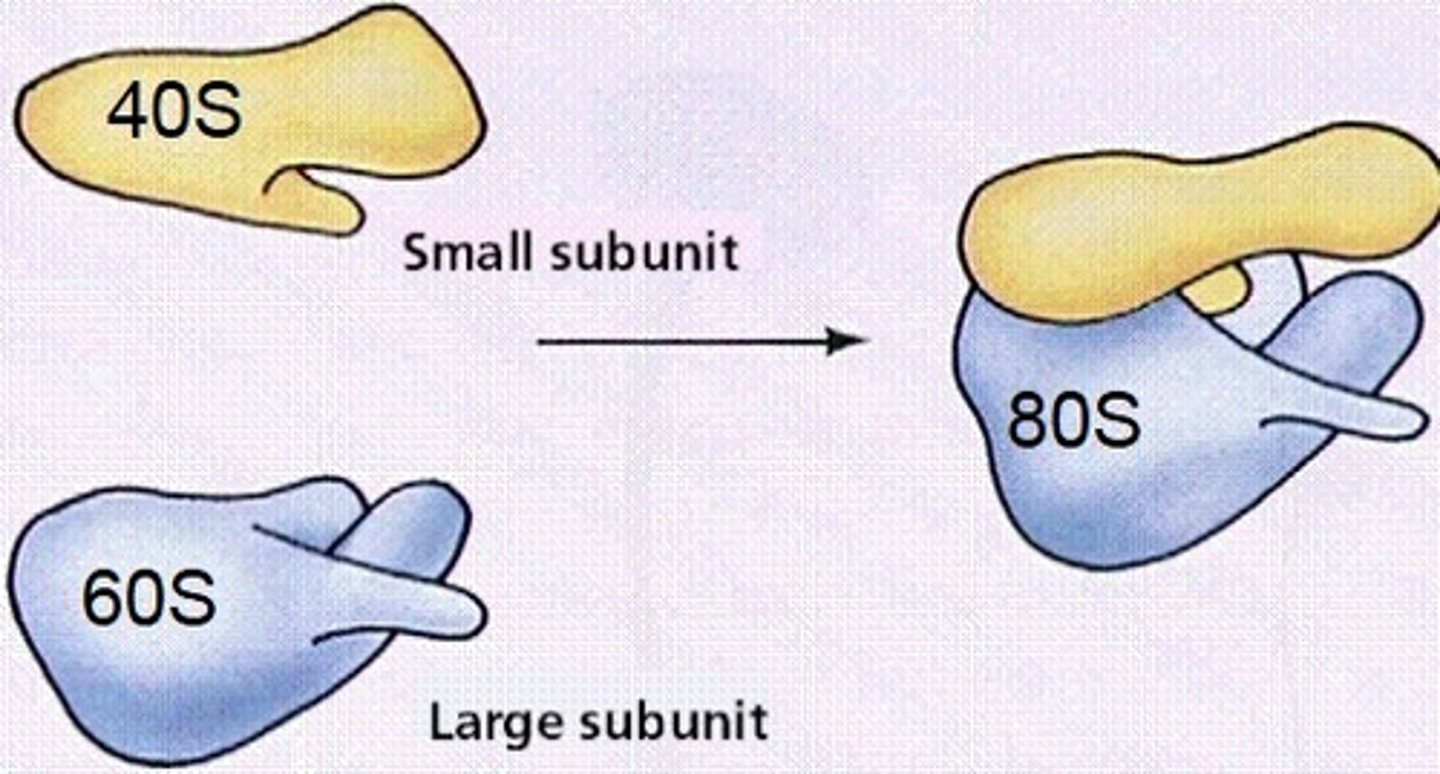
Golgi Apparatus (eukaryotic) Info and Image:
- continues processing PSD
- a series of sacs called cisternae (plural)
cisterna (singular)
- backs up to the rER
- the part that is closest to the rER is called the cis-face cisterna
- the farthest part away is called the trans-face cisterna
- PSD (proteins with a special destination) are sent via vesicle from the rEr to the cis-face cisterna
- a series if chemical reactions occurs called maturation
- meanwhile, the cisternae migrate forward (away from the rER)
- by the time the cis-face cisterna reaches the trans-face, its proteins will be mature
- now called the trans-face cisterna it will break up into vesicles, carrying the PSD to the SDs
- the trans-face cisterna disappears
- new cisternae are built on the cis-face (have three proteins one with xyz, one with abc, one with qrs)
- vesicles from the rEr bind together to build a new cis0face cisterna
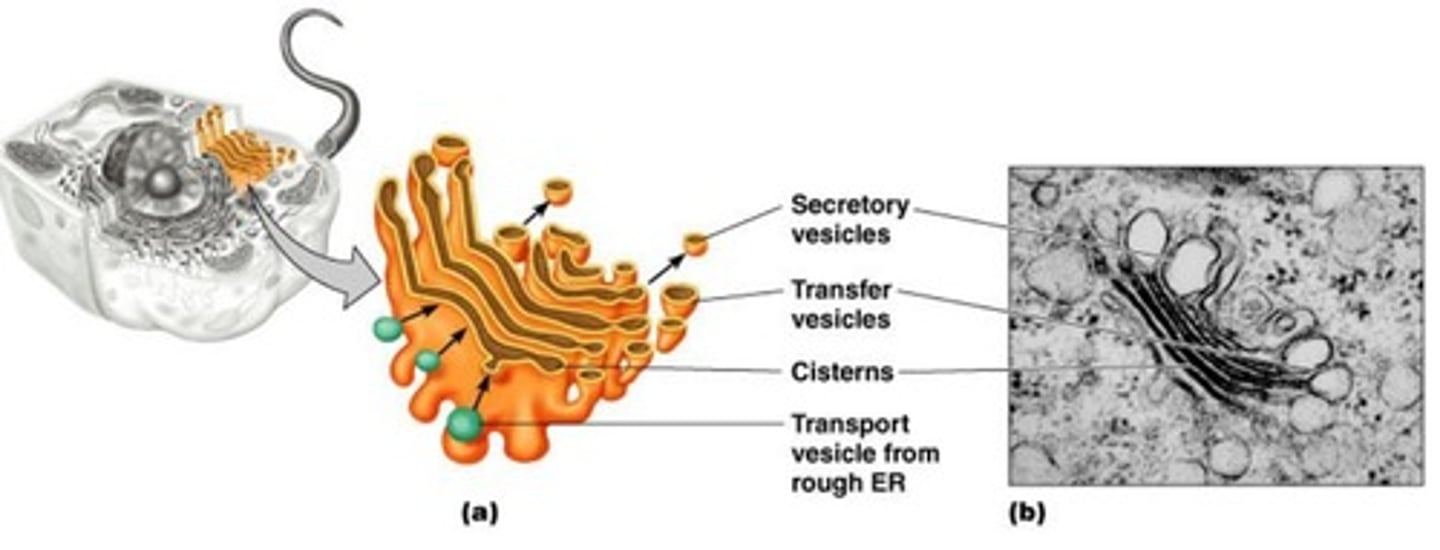
Vacuoles
- like vesicles, but permanent
- central vacuole (plants): general storage
- lysosome (animals): contains digestive enzymes, break down nutrients, recycle old cellular components
- food vacuole: brings nutrients into the cell; will merge with lysosome
- contractile vacuole: collects and removes excess H20 (osmoregulation)
Theory of Endosymbiosis
- mitochondria and chloroplasts were originally independent prokaryotic organisms (bacteria)
- somehow, each ended up inside a larger cell, but didn't get digested
- now they're just organelles
- both have their own DNA: circular prokaryotic DNA
- both have their own ribosomes: prokaryotic 305-505-705 ribosomes
- these events are proposed to have formed major branches to form on the tree of life
- mitochondria = domain eukarya
- chloroplast = kingdom plant
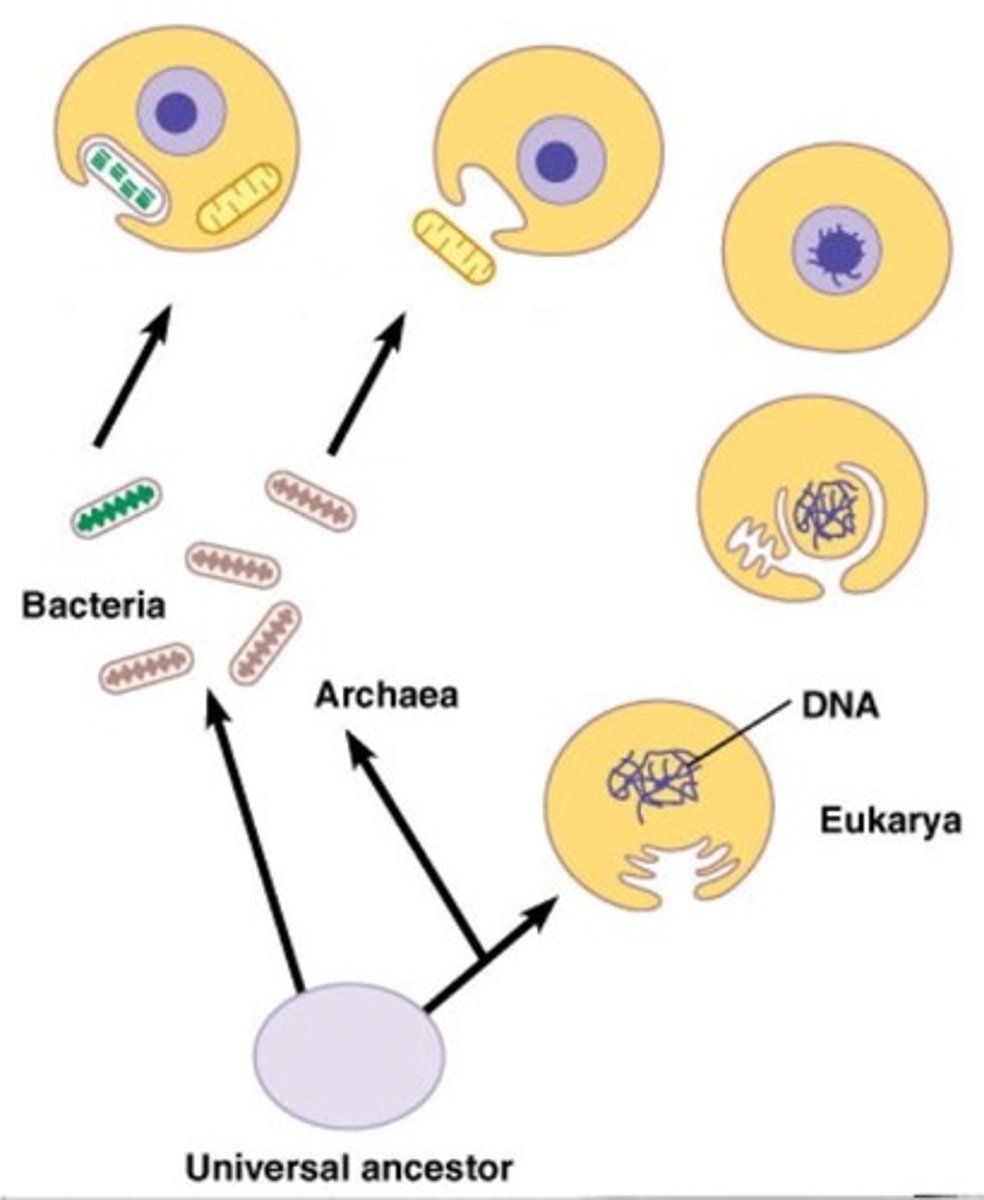
Peroxisomes
- don't come directly from the Golgi
- they pick up membrane components from the cytoplasm
- carries out numerous functions, some of which produce hydrogen peroxide (H2O2) as a by product
- enzyme catalase breaks down H2O2
2H2O2 ---> 2H2O + O2
- detoxify polar drugs (ethanol)
- converts OH to carbonyl
- acetaldehyde buildup gives you a hangover
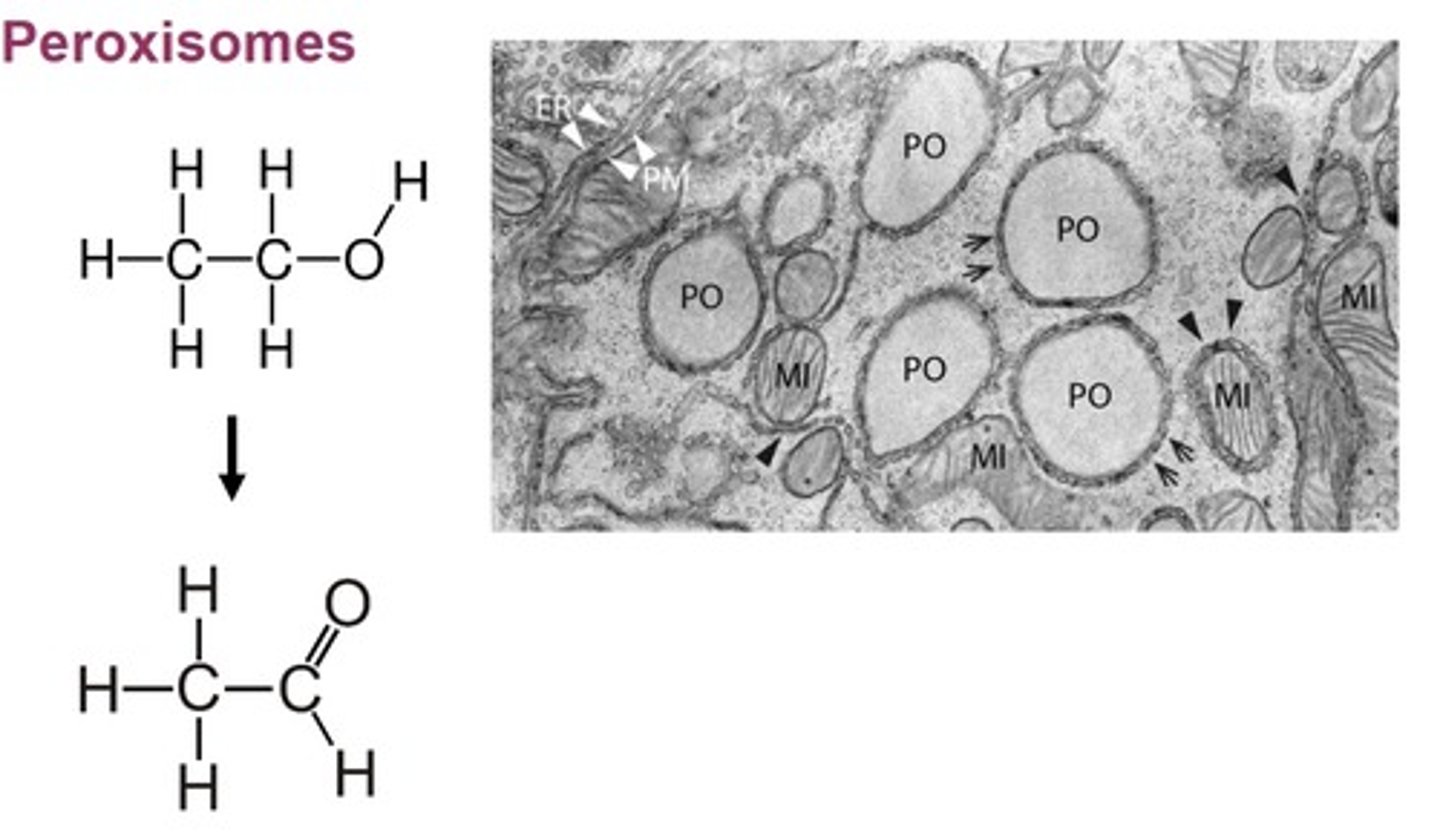
Cytoskeleton Functions
Support, Motility and Regulation
Cytoskeleton elements
1) Microtubules
2) Intermediate Filaments
3) Microfilaments
Microtubules
- hollow tube made of protein tubulin
- centrosome: the center of microtubules construction
- a pair of centrioles make a centrosome
- easily and rapidly assembled and disassembled
- eukaryotic flagellum
- mitotic spindle
- trackways for vesicles to travel on

Intermediate Filaments
- a class of filaments, made of something like Keratin
- more permanent
- supports the shape of the cell
- anchor the organelles
- nuclear lamina
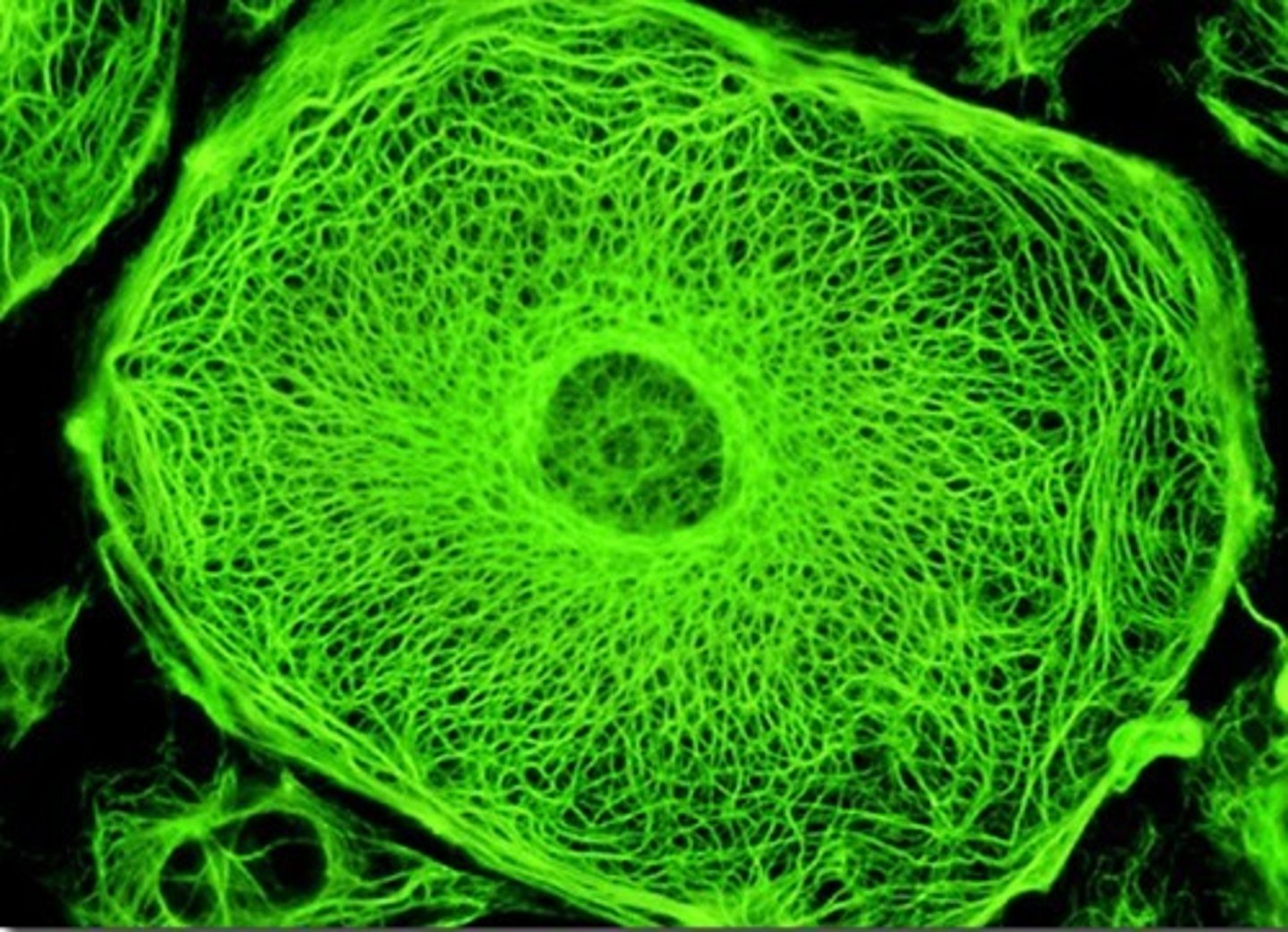
Microfilaments
- made of protein actin
- looks like a twisted string of beads (necklace)
- can be easily and rapidly assembled and disassembled
- supports shape of cell (microvilli)
- motility in single celled organisms and WBCs
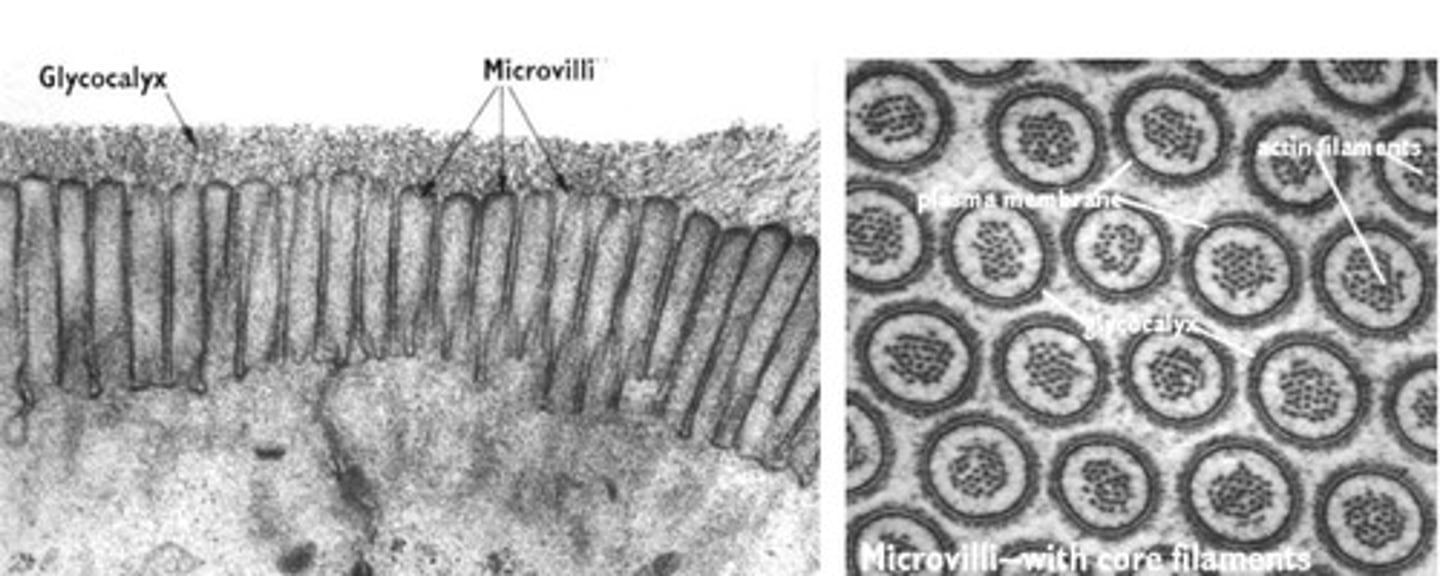
Cell junction types
1) Tight Junction
2) Desmosome
3) Gap Junction
4) Plasmodesmata
What are Cell Junctions
- proteins in cell membranes
- adjacent cells the proteins bind to hold tissues together
Tight Junction
- animal cells
- makes a tissue watertight (stomach/intestines)
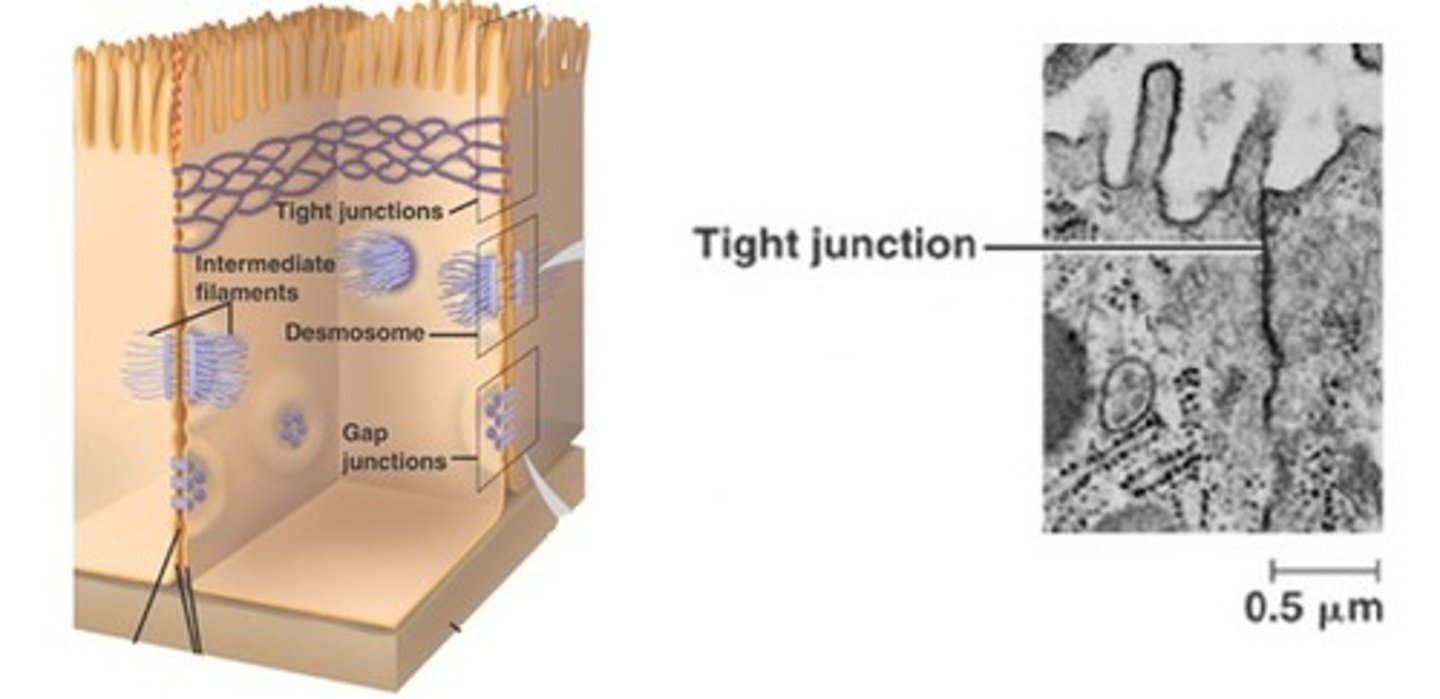
Desmosome
- animal cells
- a powerful connection in tissues that move around a lot (muscle)
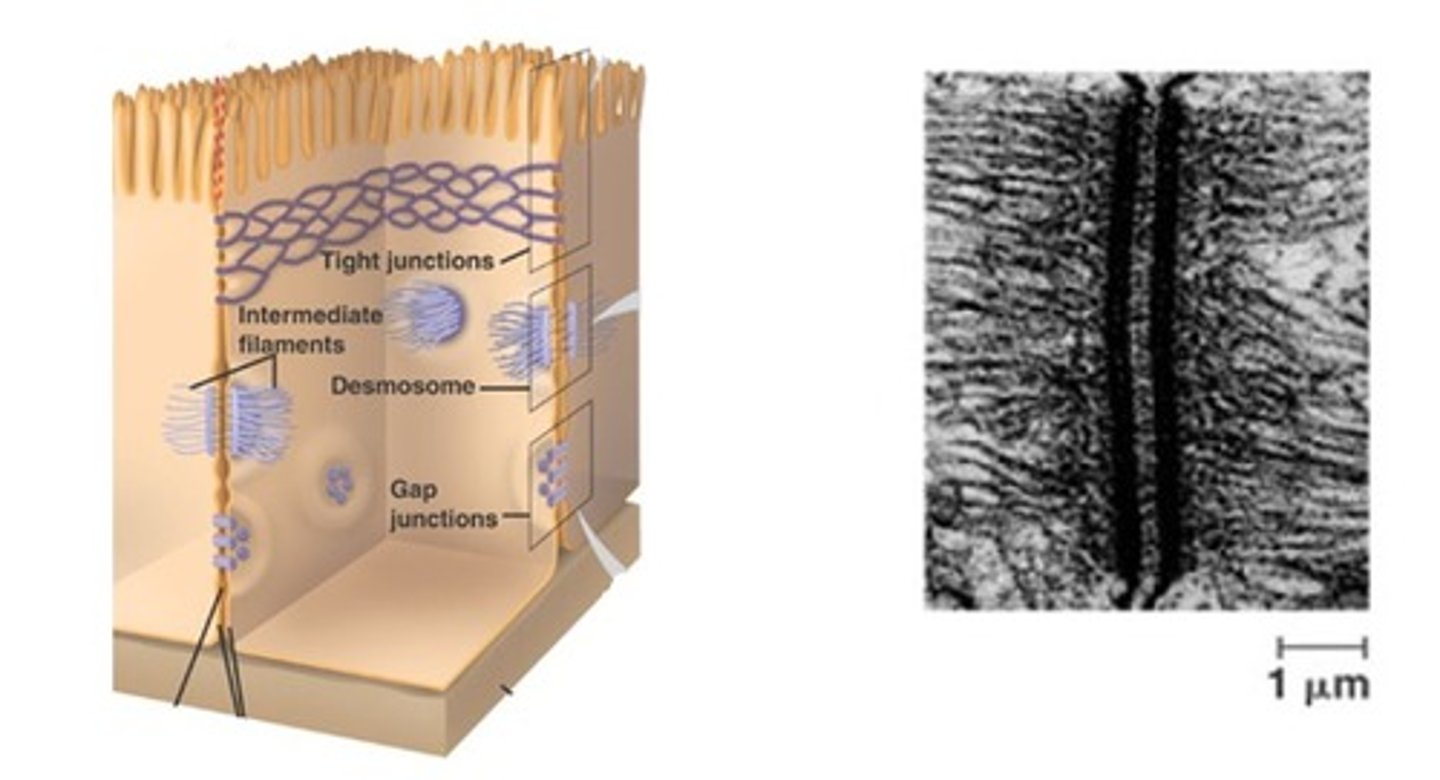
Gap Junction
- animal cells
- forms pores for rapid cell-to-cell communication (heart)
- to coordinate contraction of atria and vesicles
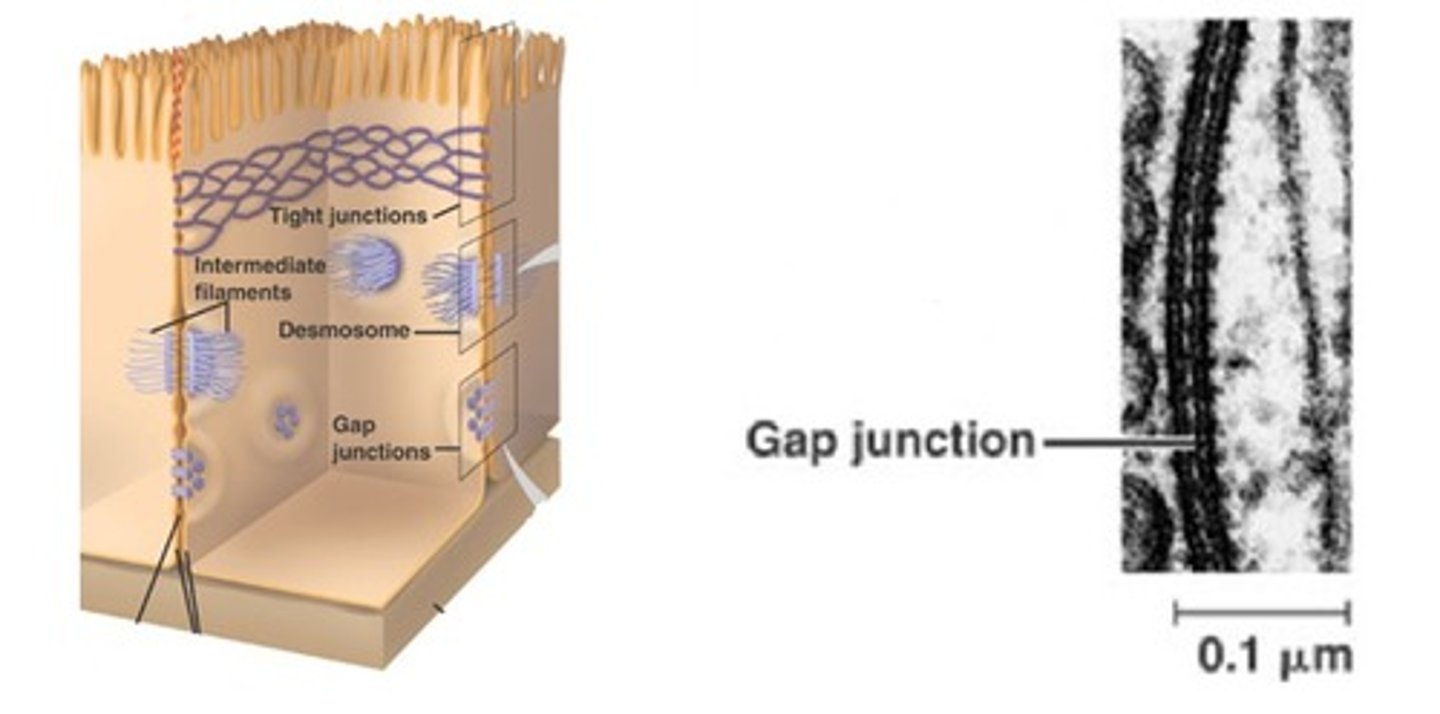
Plasmodesmata
- plant cells
- form pores that connect the cytoplasms of two adjacent cells
- rapid cell-to-cell communication